Project Management
 Effective condominium property management requires knowledge and understanding of basic project management concepts. This webpage provides an overview of these concepts and a phased approach for managing association projects. Sample document deliverables are included.
Effective condominium property management requires knowledge and understanding of basic project management concepts. This webpage provides an overview of these concepts and a phased approach for managing association projects. Sample document deliverables are included.
Here's a bar chart example of critical path scheduling. --->
Definition
A Set of Principles, Methods, Tools and Techniques (Many of Which are Relatively Old) for the Effective Management of Objective-Oriented Work (Projects) in the Context of a Specific and Unique Organization's Environment.
The Project Management Institute (PMI) defines a project as a temporary endeavor undertaken to create a unique product, service, or result. The temporary nature of projects indicates a definite beginning and end. The end is reached when the project’s objectives have been achieved or when the project is terminated because its objectives will not or cannot be met, or when the need for the project no longer exists.
A successful project is one that meets or exceeds the expectations of the stakeholders.
Project versus Process
A Project is Objective-Oriented Work which has a timeframe for completion and a fixed quantity of assigned resources. This distinguishes it from ongoing operations such as routine maintenance and repair.
Projects have:
- A Well-Defined Set of Technical Objectives
-
- What the end product will look like, what it is expected to do, and/or what problem it addresses
- Technical & functional specifications
- Applicable standards including international, national, state & local governmental, institutional & organizational. (e.g., FL statute requirements)
- Quality expectations
- Performance expectations
- Necessary technical & administrative assumptions
- A Pre-Determined Period of Performance (A deadline)
- Could include due dates for intermediate deliverables.
- A Pre-Defined Ceiling on Expenditures (A budget)
-
- Limit on human resource & capital asset utilization
- Cost of people, equipment, facilities & vendor services
- If using existing labor, how many people are assigned for how many hours?
It is important that these three project components are clearly documented prior to any project work being performed. They are normally stated in any vendor contract for project work but must also be clearly articulated for any other association projects. See the "Contracts" page of this website for further information on vendor contracts.
Project Triangle
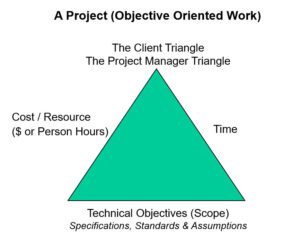 Another way of viewing the project components is via "The Client Triangle". This diagram shows the competing interests of the three components. Whenever any of the three changes, there is a corresponding change in one or two of the others. As an example, when the project scope increases, the cost and probably the timeframe also increases.
Another way of viewing the project components is via "The Client Triangle". This diagram shows the competing interests of the three components. Whenever any of the three changes, there is a corresponding change in one or two of the others. As an example, when the project scope increases, the cost and probably the timeframe also increases.
Good, Quick or Cheap Work: There is a saying that illustrates the tradeoffs:
- Good Quick work will not be Cheap.
- Good Cheap work will not be Quick.
- Quick Cheap work will not be Good.
Project Manager Expertise
Areas of expertise that a project manager should bring to the project team.
| Areas of Expertise |
| Application knowledge, standards & regulations |
| Understanding the project environment |
| Management knowledge, leadership & problem solving skills |
| Interpersonal, negotiation & communication skills |
Project Manager Responsibilities
- Assure that the project’s scope is appropriate and that its business priority is sufficient to warrant the expenditure of necessary resource.
- Coordinate development of business requirement specifications and a request for proposal (as appropriate).
- Coordinate the design, development, construction and/or purchase of deliverables that meet the system specifications and adhere to the request for proposal.
- Get agreements and commitments as to what will/can be delivered and when (this is reflected in the system specifications, project plan, and/or vendor proposal.)
- Ensure that all tasks are clearly identified, all impacted areas are addressed, and that sufficient resource is assigned.
- Develop and manage to the project plan. Know the critical path. Meet time and resource (cost) commitments.
- Ensure that the costs incurred, and labor expended in meeting the requirements and specifications are equal to the amount budgeted for the effort.
- Manage the effort so that the specifications, attained at the budgeted amount, are achieved on the date by which management desires the effort to be complete.
- Ensure that the demands of the project on the critical human resources and capital assets of the organization are equal to the approved plans for those resources and assets.
- Obtain impact estimates (risk, schedule, cost, resource utilization and asset utilization) of any requested changes.
- Assist in Arriving at a sound decision with respect to incorporating changes into the project scope. Obtain sign-off on scope changes.
- Perform specific day-to-day administrative roles/responsibilities including:
- Planning
- Coordinating
- Interfacing
- Reporting status
- Tracking progress
- Resolving issues
- Obtaining sign offs
- Assuring quality results
- Clear roadblocks through negotiation and escalation.
Basic Project Principles
- Risk Management -- Managing the risk of choosing the wrong solution/vendor, negative cost/benefit & project cost overrun.
- Sequential Phasing -- Applying an orderly phase-by-phase project plan approach without excessive phase overlap.
- Work Breakdown Structures -- Dividing project work into its lowest components: phases, activities & tasks.
- Control/Decision Points -- Examining progress after each project phase and tuning future work in accordance.
- Planning & Control Cycle -- Cycling among planning, acting, measuring & control to assure optimum results.
- Two-Level Planning/Estimating -- Planning the next project phase in detail while estimating activities and tasks of future phases and the entire project.
- Staged Commitment Levels -- Increasing commitment regarding due dates and results as remaining work and the end product becomes more clearly defined.
- Project Steering -- Welcoming management and client involvement for input/advise.
- Task Level Project Control -- Controlling projects at the detail task level.
Many of these principles are further defined below.
Work Breakdown Structures (WBS)
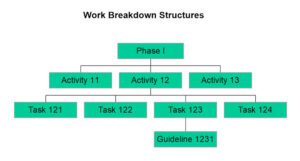 This is the concept of breaking the project components (phases) into smaller units and continuing to subdivide the work until arriving at the lowest level. This could result in tasks requiring less than a week to complete or even possibly a day.
This is the concept of breaking the project components (phases) into smaller units and continuing to subdivide the work until arriving at the lowest level. This could result in tasks requiring less than a week to complete or even possibly a day.
The WBS methodology often causes previously missing tasks to be identified and assigned.
Planning & Control Cycle
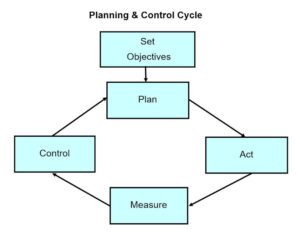 The following cyclic process provides for the constant measuring of project progress and results against objectives. Based on this analysis, the project can be better controlled and replanned as necessary.
The following cyclic process provides for the constant measuring of project progress and results against objectives. Based on this analysis, the project can be better controlled and replanned as necessary.
Without such a process and enhanced communication, management could lose track of the project's progress, or lack thereof, resulting in missed deadlines and/or scope creep. This forces manager engagement.
Two-Level Planning
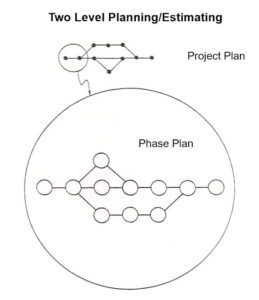 Here the concept is to flush out as much detail as possible for the current phase realizing that you may have an incomplete picture of the entire project or one or more of the subsequent phases. Then, at the end of the current phase or each subsequent phase, provide further planning of future phases.
Here the concept is to flush out as much detail as possible for the current phase realizing that you may have an incomplete picture of the entire project or one or more of the subsequent phases. Then, at the end of the current phase or each subsequent phase, provide further planning of future phases.
Because clarity is achieved within the current phase, future work requirements become clearer resulting in more complete Work Breakdown Structures (WBSs) for future phases and even the complete project.
At one of my first jobs out of college involving the installation of high-voltage transformers at an electrical substation, I had an interesting conversation with the chief engineer on the project. I mentioned that I had little experience in what I was tasked to do. He said that he had the same issue and had never before built an electrical substation. However, he said that he knew how to pour concrete and that all of the electrical equipment (transformers, current monitors, switches, busses, etc.) had to sit on concrete. He went on to say that once the concrete was poured, he would have a better picture of what the substation would look like when complete and be able to do further detail planning. This illustrates the two-level planning concept.
Task Lists
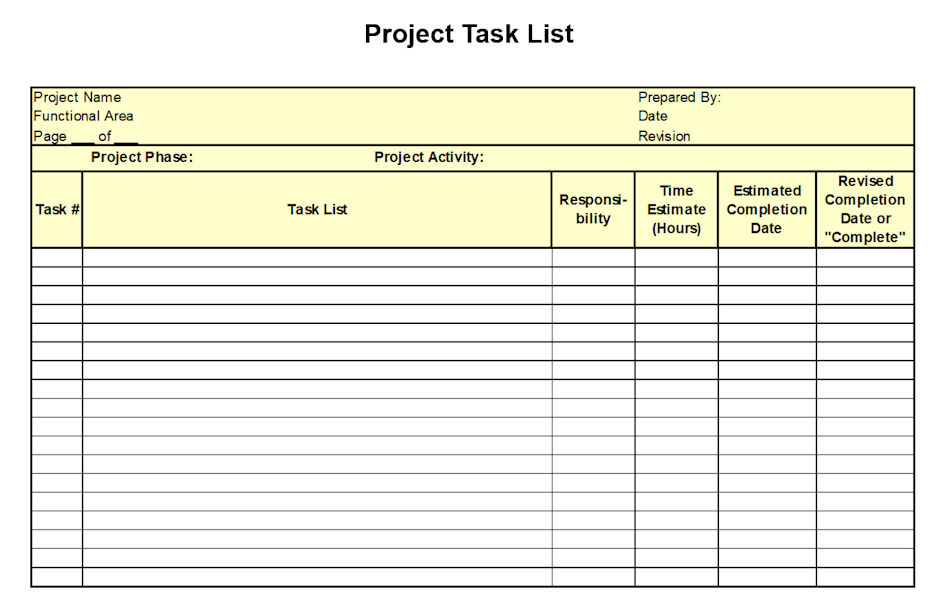 Task Lists “Feed” the Project Plan. They:
Task Lists “Feed” the Project Plan. They:
- Force project planning,
- Facilitate estimating,
- Establish the overall Project Schedule,
- Provide convenient units for adding & deleting work,
- Are used to calculate the Project’s Critical Path & end date.,
- Provide a control mechanism,
- Determine total resource needs, and
- Used to help calculate project costs.
A sample Task List form is available here and on the "Forms" page of this website.
The Center for Open Communication provides an Open Textbook Library. Textbooks in the library are considered open because they are free to use and distribute, and they are licensed to be freely adapted or changed with proper attribution. Here's a link to their textbook on Project Management.
"Laws of Project Management"
- No major project is ever installed on time, within budget, with the same staff that started it. Yours will not be the first.
- Projects progress quickly until they become 90% complete, then they remain at 90% complete forever.
- One advantage of fuzzy project objectives is that they let you avoid the embarrassment of estimating the corresponding costs.
- When things are going well, something will go wrong:
- When things just can't get any worse, they will.
- When things appear to be getting better, you have overlocked something.
- If project content is allowed to change freely, the rate of change will exceed the rate of progress.
- No system is ever completely debugged: Attempts to debug a system inevitably introduces new bugs that are even harder to find.
- A carelessly planned project will take three times longer to complete than expected; a carefully planned project will take only twice as long.
- Project teams detest progress reporting because it vividly manifests their lack of progress.
Typical Association Projects
Condominium association projects typically include:
- Building repainting,
- Roof replacement,
- Concrete restoration,
- Plumbing, sewerage & irrigation upgrading,
- Swimming pool resurfacing,
- Elevator modernization,
- Security surveillance camera installation,
- Rebuilding pool cabana or pumphouse,
- Milestone inspection & reserve study,
- Major landscape upgrade,
- Bridge replacement, and
- Safety upgrades (lighting, fire sprinklers/alarms/pumps, generators, etc.)
Determining Project Priorities
- By the Type of Work (Priority Grouping)
-
- Legal/Regulatory (e.g. milestone inspection)
- Expense Control
- Security & safety
- Rebuild/replacement of deteriorating buildings, structures, & equipment
- Expense Control
- Risk Control
- Service Improvement
- Process Improvement
- Revenue Generation
- Other
2. Ordering Within Priority Grouping is Based upon Magnitude of Impact Versus Investment Requirements (i.e. Cost Benefit Analysis).
3. Final Decisions will be made by the association's Board of Directors.
Probability of Success
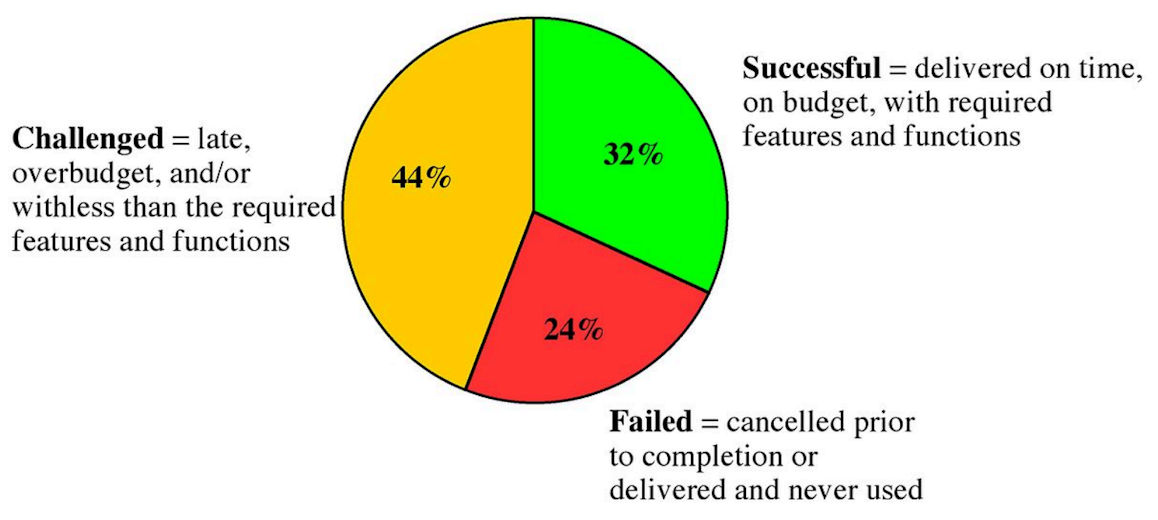 The Standish Group (a Boston-based leader in project and value performance research) released the summary version of their 2009 CHAOS Report that tracks project failure rates across a broad range of companies and industries. Here's what they found.
The Standish Group (a Boston-based leader in project and value performance research) released the summary version of their 2009 CHAOS Report that tracks project failure rates across a broad range of companies and industries. Here's what they found.
A major factor in determining project success is the amount of uncertainty in the work to be performed and the experience of the personnel performing the work. In most condominium association projects, work is being contracted to companies with vast experience, and the work performed is very repetitive and predictable. This generally results in a much-greater project success rate than shown here.
Project Manager expertise is an important ingredient in determining project success. The adjacent table shows the skill set that the manager needs.
Condominium Association Project Phases
For any condominium association project, including any of those shown in the list above, a specific and well-defined phased process needs to be followed:
- Initiation — Initiate a new project and define general business requirements. Develop a business case for the project describing the need for the end product. Present the business case to the condominium unit owners. If a vendor product or solution is being proposed, develop vendor evaluation criteria and a "Request for Proposal" to be sent to at least 3 vendors.
- Planning, Analysis & Design — Develop a response (i.e. specifications) to the requirements stating how, at a functional level, the requirements can be met. Recommend and describe a technically feasible and cost-effective design to support the requirements/functional specifications. Complete vendor selection as needed. Develop or obtain a project plan and work breakdown structure (WBS). Publish schedule of deliverables.
- Construction/Development — Develop (or purchase), document (or obtain documentation) and test the completed work product according to the business requirements and published specifications and design.
- Implementation — Install and operate the completed and fully tested work product in production with no adverse impact on the business.
- Review/Evaluation —Evaluate the system, product, project (and vendor(s)) against objectives and develop an action plan to address problems and opportunities identified.
See sections below for additional details on each project phase.
I. Project Initiation
The Initiation Phase typically consists of the following activities:
- Become cognizant of business need through property inspection, unit owner feedback, problem identification, repair/maintenance costs, or government notice.
- Determine ways of addressing the business need.
- Estimate project budget and become familiar with funding alternatives.
- Define expected benefits and develop a Business Case consisting of:
- A detailed description of the problem or opportunity that the project is addressing,
- A definition of the project's scope and objectives,
- A list of the alternative solutions available,
- An analysis of the business cost and benefits,
- A description of the preferred solution,
- Main project requirements and a summarized implementation plan, and
- Risks, Assumptions, & Constraints.
- Present Business Case to association members at a board meeting.
- Conduct initial survey of available alternative solutions and vendors.
- Develop list of requirements and publish Request for Proposal (as appropriate) to be sent to at least 3 identified vendors. The RFP generally consists of:
- Introduction and expectations,
- Project description,
- Selection criteria, and
- Proposal submission format.
- Develop vendor evaluation criteria and invite vendors to present proposals in person or via email.
- Analyze costs, resource requirements and vendor responses.
- Select preferred solution for vendor or in-house project work.
- Determine timing and funding of proposed solution/deliverable.
II. Planning, Analysis & Design
The purpose of the project Planning, Analysis & Design phase is to:
- Appoint person to coordinate project work: property manager, board member, or unit owner.
- Form Project Team or steering committee as needed.
- Conduct Depth Study of preferred solution or vendor proposal.
- Finalize vendor selection (as appropriate) and sign contracts. Save the following documents and post to them to the Association's Website:
- All executed contracts or documents to which the association or the unit owners have an obligation or responsibility,
- A list of bids received by the association within the past year.
- Summaries or copies of bids for materials, equipment, or services exceeding $500, which must be maintained on the website for 1 year.
- Publish resultant design/approach.
- Determine funding: operational account, reserves or special assessment.
- Brief unit-owners on project and obtain project and funding approval at Board Meeting.
- Establish change control process and develop Acceptance Criteria.
- Determine project Development & Implementation Plan to assure successful management and completion of the Construction and Implementation phases.
III. Construction/Development
Project work in this phase results in development, construction, or installation of the end product. Major tasks include:
- Monitor vendor progress (as appropriate).
- Assure workplace safety.
- Complete construction work.
- Process any Change Orders.
- Install equipment and/or products.
- Finalize completion date.
- Determine implementation plan.
- Obtain any necessary documentation and/or training regarding installed products or facilities.
- Determine acceptance criteria.
IV. Implementation
In this project phase the planned or contracted work is completed and implemented into production. Major activities include:
- Product or service implementation
- Turnover to steady-state condition.
- Accept completed product and sign-off on final deliverables.
- Pay any open invoices and secure any vendor lien releases. See sample Lien Release form.
- Proform any necessary conversion tasks.
- Operate completed product in production.
- Determine ongoing maintenance requirement.
V. Review/Evaluation
This project phase closes out the project. Major activities include:
- Evaluate the new system or product against specifications.
- Evaluate project management performance.
- Develop shortage/discrepancies list.
- Determine any follow-up task requirements.
- Determine product support or maintenance requirements.
- Develop funding plan for ongoing maintenance.
- Determine any impact on budget reserves or operating costs.
- Save project documents as official records for 7 years.
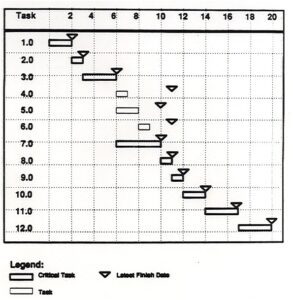 Effective condominium property management requires knowledge and understanding of basic project management concepts. This webpage provides an overview of these concepts and a phased approach for managing association projects. Sample document deliverables are included.
Effective condominium property management requires knowledge and understanding of basic project management concepts. This webpage provides an overview of these concepts and a phased approach for managing association projects. Sample document deliverables are included.